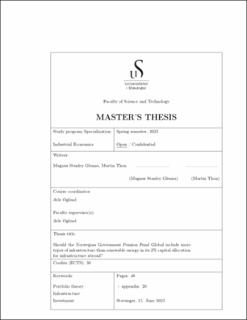| dc.description.abstract | This thesis examines whether the Norwegian Government Pension Fund Global could benefit from including more types of infrastructure than renewable energy in its 2% capital allocation for infrastructure abroad. This led to the research question: "Should the Norwegian Government Pension Fund Global include more types of infrastructure than renewable energy in its 2% capital allocation for infrastructure abroad?".
In particular, the thesis will examine energy, telecom, and transportation infrastructure in addition to renewable energy. As of 2023, the Ministry of Finance has mandated a maximum capital allocation limit of 2% towards infrastructure investments. Despite the mandated limit, only 0,1% of the fund is currently invested in infrastructure.
To address the research question, financial data from 115 companies across six countries (United States, France, Spain, South Korea, India, and China) and four sectors (energy, renewable, telecom, and transport) were analyzed for the period of 2017-2021. The financial data of each company was used to calculate the expected return, standard deviation, and Sharpe ratio. Return on equity served as the financial ratio for determining the expected return. A covariance matrix was created to assess the correlation between companies and the overall risk exposure of equally weighted portfolios in each sector, as well as a portfolio including all sectors and companies.
The results indicate that Norwegian Government Pension Fund Global should continue focusing on renewable investments, as it was the only sector with a Sharpe ratio above one, suggesting that the return generated is higher than the risk taken. A comparison between net profit margin and return on equity using the coefficient of variation was also done to see if changing the financial ratio could change the outcome. However, the comparison indicated that the renewable sector was one of the most stable and profitable sectors, supporting the initial conclusion. | |
